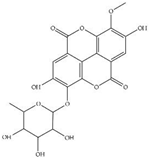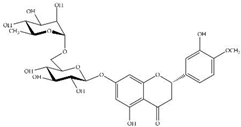Abstract
Polygonum odoratum var. Pakphai has been used in traditional Thai medicine for the treatment of flatulence and constipation and to relieve the inflammation caused by insect bites. Quercetin (Q), which is abundant in plant-based foods, has been found to exert anti-inflammatory properties. This study evaluated the anti-inflammatory activity of P. odoratum ethanolic extract in RAW264.7 macrophage cells. Leaves were extracted with 50% ethanol, phenolics and flavonoids were then analyzed using UHPLC-QTOF-MS and HPLC-DAD. RAW264.7 cells were induced with lipopolysaccharides (LPSs). They were then treated with the extract and prostaglandin E2 (PGE2), and interleukin-6 (IL-6) and tumor necrotic factor-alpha (TNF-α) concentrations were determined. Levels of cyclooxygenase-2 (COX-2), inducible nitric oxide synthase (iNOS), IL-6 and TNF-α mRNAs were analyzed using qRT-PCR. Chemical analysis demonstrated that the extract was abundant with Q while also containing catechin, gallic acid, epicatechin gallate and coumarin. The extract increased the viability of RAW264.7 cells and dose-dependently decreased nitric oxide production, PGE2, IL-6 and TNF-α levels in the medium from the LPS-induced RAW264.7 cell culture. Consistently, COX-2, iNOS, IL-6 and TNF-α mRNA levels were decreased in a concentration-dependent manner (p < 0.05). Thus, the quercetin-rich ethanolic extract derived from P. odoratum var Pakphai leaves can exert anti-inflammatory activity in LPS-induced RAW264.7 cells through a reduction of the pro-inflammatory mediator response.
1. Introduction
The current state of inflammation is recognized as an immune process that responds to specific stimuli, such as certain microorganisms, tissue injuries and the presence of certain chemicals [1]. Inflammatory processes involve vascular changes and white blood cell responses. Macrophages are the main phagocytotic cells that respond by releasing several pro-inflammatory mediators, such as tumor necrosis factor-alpha (TNF-α), interleukin-1beta (IL-1β), interleukin-6 (IL-6) and other chemo-attractants, to eliminate noxious stimuli and assist in repairing the affected tissue [2]. In addition, TNF-α activates the expression and synthesis of inducible nitric oxide synthase (iNOS), resulting in an increased production of nitric oxide radicals (NO•). During the inflammation process, cyclooxygenase-2 (COX-2) catalytically converts arachidonic acid to prostaglandin E2 (PGE2), a main inflammatory mediator that is associated with pain, swelling, redness and heat [3]. Importantly, inflammation is a major factor for the progression of various chronic diseases, including diabetes, cancer, cardiovascular disease, arthritis, obesity, autoimmune diseases and inflammatory bowel disease [4,5].
Polygonum odoratum Lour. (Family Polygonaceae), which has been reclassified as Persicaria odorata, was originally cultivated by the Hmong people in China and Laos for cooking with fish and exotic herbs [6]. It is a biennial edible plant that has a hot, spicy taste and a strong coriander-like aroma. In addition, it is usually used to add flavor and aroma to various Thai dishes. Other synonyms currently being used to refer to this plant include rau ram or sang hum in Viet Nam, where it is referred to as mint or coriander in Vietnamese cuisine. It is also known as Daun Laksa or the Laksa plant in Malaysia. Furthermore, it is known as Paew in the northeast and Pakphai in the northern regions of Thailand. Interestingly, the plant leaves are commonly used as an antidiabetic, anti-microbial, anti-inflammatory and anti-tumor agent in Asian traditional medicine. It has been used in Thai traditional medicine for the treatment of flatulence, constipation and the localized inflammation caused by insect bites [7]. Nowadays, qualitative analysis involving high-performance liquid chromatography coupled with electrospray ionization-mass spectrometry (HPLC–ESI-MS), comprehensive analysis, such as ultrahigh-performance liquid chromatography coupled with electrospray ionization-quadrupole time-of-flight-mass spectrometry (UHPLC-ESI-QTOF-MS/MS), and quantitative analysis, such as high-performance liquid chromatography-diode array detection (HPLC-DAD) are rapid and sensitive liquid chromatographic techniques that can be used to identify major chemical components (such as phenolics and flavonoids) and secondary metabolites in natural and extracted plant parts. Accordingly, the obtained samples are tested for toxicity or investigated for their biological and pharmacological activities [8,9,10,11,12,13,14].
Evidence suggests that the ethanolic extracts of the aerial sections of P. odoratum contain scutellarein-7-glucoside and quercitrin, while exhibiting anti-inflammatory activity in lipopolysaccharide (LPS)-induced murine RAW264.7 macrophage cells [15]. Moreover, a previous study has recently reported that P. odoratum leaf extract abundant with phenolic compounds can exert strong antioxidant, anti-cancer and anti-microbial activities [16]. In product formulations, alginate-encapsulated P. odoratum ethanolic extract beads were found to possess an efficient anti-bacterial property by completely inhibiting Staphylococcus aureus and Escherichia coli growth in agar [17]. However, the anti-inflammatory effects associated with the pro-inflammatory response are still unclear. The present study focused on analyzing the major active phenolic compounds in the ethanolic extracts of P. odoratum var. Pakphai leaves, evaluating the toxicity in murine RAW264.7 macrophages and investigating the anti-inflammatory activity in LPS-induced RAW264.7 cells.
2. Results
2.1. Extraction Yield, Total Phenolic and Flavonoid Contents
Interestingly, in terms of the mean ± standard error of the mean (SEM) values, 50% of ethanolic extractions of P. odoratum cv. Pakphai leaves produced an average yield of 18.96% (w/w), for which the total phenolic content (TPC) and total flavonoid content (TFC) values were 52.59 ± 0.58 mg gallic acid equivalent (GAE)/g extract and 19.97 ± 0.11 mg quercetin equivalent (QE)/g extract, respectively.
2.2. UHPLC-ESI-QTOF-MS/MS Profiling of the Extract
MS experiments on the UHPLC-MS system coupled with the ESI source, QTOF and an ion trap mass spectrometer were carried out in order to investigate and identify the presence of different isobaric compounds and to perform a comprehensively qualitative analysis of the phenolic constituents present in 50% ethanolic extract of P. odoratum Lour. cv. Pakphai leaves. The ESI–MS base peak chromatogram of the extract shows a relatively complex mixture containing peak quantities of phenolics, flavonoids and lignans. Apparently, these two phenolics included epicatechin (EC) at TR 17.312 min and gallocatechin (GC) at TR 18.242 min. Two flavonoids included quercetin 3′-O-glucuronide (QG) at the time of retention (TR) at 9.455 min and 5,7,8,3′,4′-pentahydroxyisoflavone or quercetin (Q) at TR 14.787 min, and one lignan included 3-methylellagic acid 8-rhamnoside at TR 11.016 min. These were identified using fragmentation patterns observed in tandem mass spectra (Figure 1). Accordingly, estimated and exact mass formulae and the chemical structures of the possible compounds are presented in Table 1. Interestingly, hesperidin (TR 21.531 min), which is a flavanone glycoside found in citrus fruits whose aglycone form is called hesperetin, was detected in the extract. However, six other peaks eluted at TR values of 0.356, 0.677, 0.913, 2.112, 17.112 and 22.146 min could not be identified herein due to a lack of pertinent information and an established database.
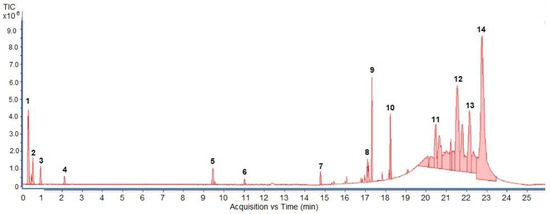
Figure 1.
UHPLC–ESI-QTOF-MS/MS extracted ion chromatogram produced from 50% ethanolic extract of P. odoratum Lour. cv. Pakphai leaves at the selected deprotonated molecules [M—H]−. Abbreviations: TIC = total ion counts, UHPLC-ESI-QTOF-MS/MS = ultrahigh-performance liquid chromatography–electrospray ionization-quadrupole time-of-flight-mass spectrometry/mass spectrometry.

Table 1.
UHPLC–ESI-QTOF-MS/MS identification of phenolic compounds in 50% ethanolic extract of P. odoratum Lour. cv. Pakphai leaves.
2.3. HPLC-DAD Analysis of Phenolic Compounds in the Extract
For the purposes of calibration, different concentrations of mixed standard phenolics (10 μL) were injected into the HPLC system to indicate the relative phenolic compounds present in the extract eluted from the column and to establish the standard curves needed to calculate the appropriate concentrations. In our findings, the standard GA, C, EGCG, EC, ECG, CO and Q quantities came out at specific TR values of 7.02, 12.27, 14.00, 15.40, 17.28, 21.27 and 26.48 min, respectively. Correspondingly, GA, catechin (C), epicatechin 3-gallate (ECG), coumarin (CO) and Q were detected in the ethanolic extract of P. odoratum Lour. cv. Pakphai leaves (Figure 2A), while epigallocatechin 3-gallate (EGCG) and EC were not detected (Figure 2B). Accordingly, concentrations of the five phenolics were determined from the standard curves and have been expressed in Table 2, of which Q was the most abundant and ECG was the second most abundant.
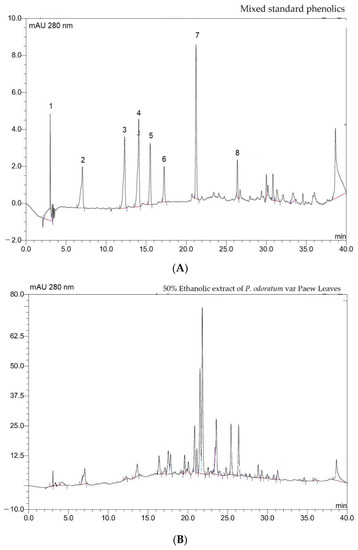
Figure 2.
HPLC-DAD profile of phenolic compounds in the mixed standards that included gallic acid, catechins, epigallocatechin 3-gallate, epicatechins, epicatechin gallate, 20 μg coumarin, quercetin (A) and 50% ethanolic extract of P. odoratum Lour. cv. Pakphai leaves (B).

Table 2.
HPLC-DAD analysis of the phenolic content in 50% ethanolic extracts of P. odoratum Lour. cv. Pakphai leaves. Data obtained from two separate experiments are expressed as mean ± standard errors of mean (SEM) values.
2.4. Toxic Effect on RAW264.7 Macrophage Cells
Clearly, all concentrations of the extracts exerted no cytotoxic effects on RAW264.7 macrophages. Concentrations of 25–200 μg/mL significantly increased cell viability in a concentration-dependent manner, while concentrations of >200 μg/mL did not have any influence (Figure 3).
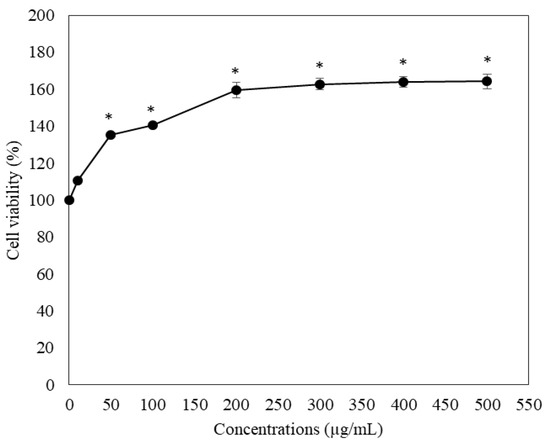
Figure 3.
MTT test-based viability of RAW264.7 macrophage cells treated with 50% ethanolic extracts of P. odoratum Lour. cv. Pakphai leaves. Data obtained from three independent experiments are expressed as mean ± SEM values. Accordingly, * p < 0.05 was considered significant when compared with untreated cells. MTT = 3-(4,5-dimethyl-2-thiazolyl)-2,5-diphenyl-2-H-tetrazolium bromide, SEM = standard error of the mean values.
2.5. Effect on Nitric Oxide Production and Inducible Nitric Oxide Synthase Gene Expression
In the present study, LPS treatment markedly increased levels of NO• production in RAW264.7 macrophages when compared with control cells without treatment (p < 0.05); nevertheless, increasing NO• values were dose-dependently reduced in macrophages following treatment with the extract (100, 200 and 400 μg/mL) with a half maximal inhibitory concentration (IC50) value of >400 μg/mL) (p < 0.05) (Figure 4A). Moreover, iNOS mRNA levels were evidently increased in LPS-induced cells (p < 0.05) when compared with control cells without LPS induction. Consistently, the extracts were found to decrease in accordance with the increasing iNOS mRNA expression in a concentration-dependent manner (p < 0.05) when compared with the cells that did not undergo extract treatment (Figure 4B).
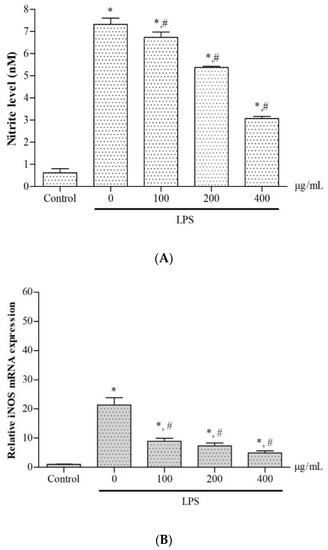
Figure 4.
Levels of NO• production (A) and iNOS gene expression (B) in LPS-induced RAW264.7 macrophages after treatment with 50% ethanolic extract of P. odoratum Lour. cv. Pakphai leaves (100, 200 and 400 μg/mL) for 24 h. Data obtained from three independent experiments are expressed as mean ± SEM values. Accordingly, * p < 0.05 was considered significant when compared to cells without LPS induction; # p < 0.05 was considered significant when compared to LPS-induced cells without the extract treatment. Abbreviations: iNOS = inducible nitric oxide synthase, LPS = lipopolysaccharide, NO• = nitric oxide radical, SEM = standard error of the mean values.
2.6. Inhibitory Effects on Cyclooxygenase 2 Gene Expression and PGE2 Production
In terms of the relevant pharmacological effects, cyclooxygenases (COXs) comprise constitutive COX or cyclooxygenase 1 (COX-1) and inducible COX (COX-2), which catalyze a conversion of arachidonic acid to prostaglandins, in particular PGE2, resulting in inflammation. Herein, we have investigated whether the ethanolic extract would exert inhibitory effects on COX-2 gene expression and PGE2 production in LPS-induced murine RAW264.7 macrophages, indicating an anti-inflammatory activity. Thus, we have assessed levels of COX-2 mRNA expression in the macrophages with the use of qRT-PCR and PGE2 production in the culture medium using ELISA. According to our findings, COX-2 mRNA expression in LPS-induced macrophages was highly upregulated by LPS stimulation (p < 0.05), while increases in COX-2 mRNA were dose-dependently decreased by treatment with the extract (p < 0.05) (Figure 5). Consistently, the results provide evidence that PGE2 levels were significantly increased in LPS-induced RAW264.7 macrophages when compared with control cells without LPS induction. The treatment with the extract decreased PGE2 production in a concentration-dependent manner with an IC50 value of 231.9 μg/mL) (p < 0.05) when compared with LPS-induced cells without the extract treatment (Figure 6).
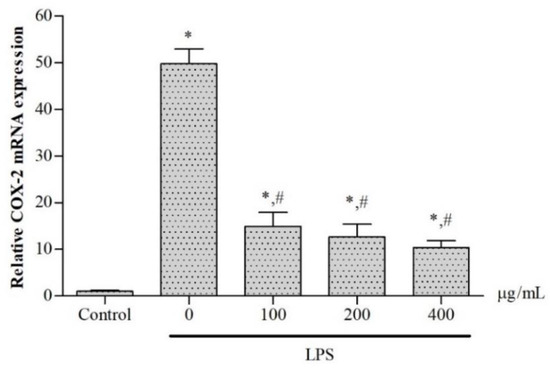
Figure 5.
Levels of COX-2 mRNA expression in LPS-induced RAW264.7 macrophages after treatment with 50% ethanolic extract P. odoratum Lour.cv. Pakphai leaves at various concentrations for 24 h. Data obtained from three independent experiments are expressed as mean ± SEM values. Accordingly, * p < 0.05 was considered significant when compared to control cells without LPS induction; # p < 0.05 was considered significant when compared to LPS-induced cells without the extraction treatment. Abbreviations: COX-2 = cyclooxygenase 2, LPS: lipopolysaccharide, SEM = standard error of the mean values.
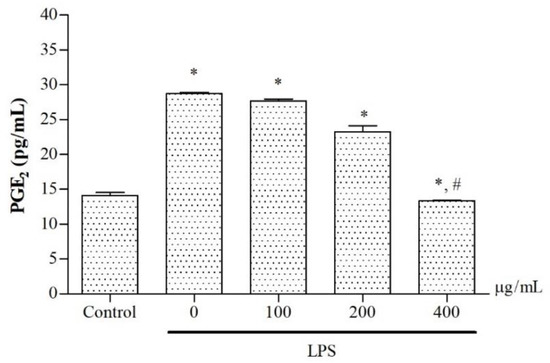
Figure 6.
Levels of PGE2 production in LPS-induced RAW264.7 macrophages after being treated with 50% ethanolic extract of P. odoratum Lour. cv. Pakphai leaves at various concentrations for 24 h. Data obtained from three independent experiments are expressed as mean ± SEM values. Accordingly, * p < 0.05 was considered significant when compared to control cells without LPS induction; # p < 0.05 was considered significant when compared to LPS-induced cells without the extraction treatment. Abbreviations: COX-2 = cyclooxygenase 2, LPS: lipopolysaccharide, SEM = standard error of the mean values.
2.7. Effects on Production and Gene Expression of Pro-Inflammatory Cytokines
LPS stimulation was found to increase levels of IL-6 concentrations and mRNA (p < 0.05) in murine RAW264.7 macrophages when compared with the control cells; however, treatment with the extract significantly lowered the increasing IL-2 levels in a concentration-dependent manner (Figure 7A,B). Similarly, LPS also increased levels of TNF-α concentrations and mRNA (p < 0.05) when compared with the control cells, while treatment with the extract significantly decreased the production and gene expression of TNF-α in a concentration-dependent manner with an IC50 value of 285.3 μg/mL) (Figure 7C,D). The results indicate the anti-inflammatory effects of ethanolic extract of P. odoratum Lour. cv. Pakphai leaves in macrophages.

Figure 7.
Levels of IL-6 production (A) and mRNA expression (B), as well as TNF-α production (C) and mRNA expression (D), in the medium obtained from the cultured RAW264.7 macrophage induced by LPS and treated with 50% ethanolic extract of P. odoratum Lour. cv. Pakphai leaves. Data obtained from three independent experiments are expressed as mean ± SEM values. Accordingly, * p < 0.05 was considered significant when compared to the control cells without LPS induction; # p < 0.05 was considered significant when compared to LPS-induced cells without the extraction treatment. Abbreviations: LPS = lipopolysaccharide, SEM = standard error of the mean values, TNF-α = tumor necrotic factor-alpha.
3. Discussion
Traditionally, the P. odoratum Lour. plant was cultivated in urban gardens by members of Hmong hilltribes in Lao who typically produced edible vegetables with high mineral profiles (e.g., Ca, Mg and Mn), various fish seasonings, natural components of suggested pregnancy and post-partum diets and formulated a variety of medicinal herb recipes [6]. Giving it its aromatic odor, the aerial parts of this plant contain many volatile organic compounds, including (Z)-3-hexenal, (Z)-3-hexenol, decanal, undecanal, dodecanal, 3-sulfanyl-hexanal and 3-sulfanyl-hexan-1-ol [18]. Due to its pungent taste, the leaves of this plant contain various active compounds, such as polygodial. Furthermore, the leaves have been determined to contain 1,4-dialdehyde, which is derived from drimane terpenoids [18]. Additionally, fresh P. odoratum leaves were found to contain a range of essential oils that comprise twenty-five compounds, of which dodecanal, decanal and anisaldehyde were the most abundant and exhibited an inhibitory effect on tyrosine activity and Salmonella choleraesuis growth [16,19]. Our previous study has demonstrated that only the methanol extract of P. odoratum var. Pakphai leaves were abundantly present in phenolics and flavonoids together with E-15-heptadecenal and 3,7,11,15-tetramethyl-2-hexadecen-1-ol, which exhibited strong free-radical scavenging properties [7]. The chromatogram of the leaf extract shows the chemical composition of QG, 5,7,8,3′,4′-pentahydroxyisoflavone and 3-methylellagic acid 8-rhamnoside, of which QG was found to possess potent anti-cancer [20], anti-aging [21] and antioxidant properties [22]. A number of previous studies have reported on the anti-inflammatory properties of QG that suppressed a pro-inflammatory mediator response on LPS-stimulated RAW264.7 macrophage cells [23,24] and inhibited vascular permeability in mice [25]. Likewise, 5,7,8,3′,4′-pentahydroxyisoflavone or quercetin is an isoflavone derivative that has been reported to possess remarkable anti-inflammatory effects [26] and anti-proliferative activities [27]. Our present study also produced a polyphenolic profile using HPLC-DAD and UHPLC-ESI-QTOF-MS/MS methods. It has been confirmed that 50% (v/v) ethanolic extract of the plant leaves contain high levels of quercetin and have also been found to contain epicatechin gallate, coumarin, gallic acid and catechin.
With regard to the potential health benefits of this plant, the leaves contain high amounts of bioactive ingredients that exhibit antioxidant, anti-hemolytic and anti-bacterial properties. As an alternative form of osteoporosis therapy, the oral administration of Morus alba and P. odoratum leaves over a period of 3 months effectively decreased levels of bone oxidative stress markers and osteoclast density but elevated serum calcium, alkaline phosphatase (ALP) and osteocalcin levels. The administration also increased osteoblast density and cortical thickness in treated ovariectomized rats [28]. Consistently, the data obtained from a randomized double-blind placebo-controlled clinical trial has supported the contention that the consumption of M. alba leaf extract (50 mg/day) combined with P. odoratum leaf extract (1500 mg/day) for 8 weeks could elevate serum levels of ALP, osteocalcin and TPC but could effectively reduce serum beta-isomerized C-terminal telopeptide levels in menopausal subjects [29]. We have previously demonstrated that water, dichloromethane and the methanolic extracts derived from Pakphai leaves were not toxic to RAW264.7 macrophages and exhibited an anti-inflammatory activity in LPS-induced RAW264.7 cells, of which an IC50 value of dichloromethane = 53.75 ± 0.75 μg/mL was achieved by inhibiting the production of NO• [7]. The present study using a colorimetric MTT test has determined that extract doses at 100–400 μg/mL were not toxic to RAW264.7 cell cultures but seemed to increase cell viability. Similarly, Okonogi and coworkers reported on the nontoxic effect of the ethanolic extract fractions (10–100 μg/mL) that included scutellarein-7-glucoside and quercitrin on RAW264.7 cells. Importantly, the doses they administered were in much lesser quantities than the ones we had used in our experiments [15]. Although macrophages play essential roles in anti-inflammatory defense mechanisms, the abnormal activation of macrophages has been reported in the development of many inflammatory disorders, including sepsis, rheumatoid arthritis, inflammatory bowel disease and cancer. Under pathogenic conditions, an excessive amount of pro-inflammatory mediators and cytokines are produced from abnormally activated macrophages that eventually provoke an inflammatory response [30]. Therefore, the inhibition of abnormal macrophage activation might be an invaluable therapeutic goal in the treatment of inflammatory disorders.
Several previous studies have reported on the anti-inflammatory activity facilitated by quercetin, which was found to be abundant in the ethanolic extracts of various plant-derived products and compounds. The ethanolic extract of Myrsine seguinii is rich in Q, which was found to inhibit inflammatory responses (such as production of NO• and PGE2) in LPS-stimulated RAW264.7 cells and LPS-induced mouse peritonitis by blocking the Src/Syk/nuclear factor kappa B (NF-κB) and the IL-1 receptor-associated kinase 1/activator protein 1 (IRAK-1/AP-1) pathways [31]. Additionally, 50% ethanolic extract of persimmon leaves potently inhibited the production of NO•, PGE2 and IL-6 in LPS-induced RAW264.7 cells [32]. Likewise, the ethanolic extract of the Euphorbia kansui root containing ingenane diterpenoids (euphorkans A and B), together with 16 known analogues, exerted an anti-inflammatory activity that was consistent with Q by inhibiting the effects of certain inflammation mediators, such as TNF-α and IL-6, in a concentration-dependent manner through the inhibition of NF-κB activity [33]. Moreover, the ethanolic extract of the QingXiaoWuWei decoction, containing quercetin and other ingredients, exhibited synergistic anti-inflammatory activity in the LPS-induced RAW264.7 cell culture via JUN, MAPK1 and AKT1 targets and the mitogen-activated protein kinases (MAPK)/phosphatidylinositol-3 kinase (PI3K)/Akt serine/threonine kinases pathways [34].
In this study, we found that the ethanolic leaf extracts of this plant contain high amounts of phenolic compounds and flavonoids. Notably, our ethanolic extract of P. odoratum leaves (100–400 μg/mL) significantly attenuated pro-inflammatory mediators and cytokine production, such as NO•, PGE2, IL-6 and TNF-α, in LPS-induced RAW264.7 cells in a concentration-dependent manner. Consistently, the extract also down-regulated the gene expression of iNOS, COX-2, IL-6 and TNF-α. In contrast, secretion of IL-6, but not TNF-α, was found to be significantly reduced in a concentration-dependent manner with 50% and 100% ethanolic extracts (10–100 μg/mL) of P. odoratum leaves (IC50 = 25 μg/mL), the scutellarein-7-glucoside fraction (IC50 = 102 μM) and the quercitrin (IC50 = 77 μM) extract, all of which emphasized the anti-inflammatory activity of scutellarein-7-glucoside and quercitrin [15]. Moreover, the hot water extract of P. odoratum leaves, which are known to be abundant with TPC (223.0 ± 9.7 mg GAE/mg extract) and comprise GA (7.63 ± 0.30 mg/g), ellagic acid (3.31 ± 0.14 mg/g), C (1.77 ± 0.10 mg/g), rutin (0.40 ± 0.20 mg/g), Q (0.08 ± 0.01 mg/g), caffeic acid (0.07 ± 0.01 mg/g), kaemferol (0.02 ± 0.00 mg/g) and ferulic acid (0.02 ± 0.00 mg/g), exerted antioxidant activities by decreasing malondialdehyde levels while increasing levels of catalase, superoxide dismutase and glutathione peroxidase activities in RAW264.7 cells exposed to X-ray irradiation [35]. Furthermore, the water extract of P. odoratum leaves decreased contractions of 80 mM potassium chloride-induced rat ileum in a dose-dependent manner, possibly by increasing the production of NO• via the β-adrenergic receptor pathway and by blocking the calcium influx [36].
Herein, our findings suggest the potent anti-inflammatory effect of specific major active compounds, particularly quercetin and isoflavone derivatives, in the ethanolic extracts of P. odoratum var. Pakphai leaves through suppression in the responses of certain pro-inflammatory mediators, such as NO•, PGE2, IL-6 and TNF-α in LPS-stimulated murine macrophage cells. The underlying mechanism of quercetin on the pro-inflammatory mediator in macrophages has been demonstrated, wherein LPS activates MAPKs, such as extracellular signal-regulated kinases, c-Jun N-terminal kinase and p38 MAPK [37]. In addition, the transcription factors that occur under LPS-stimulated inflammatory conditions are downstream targets of the MAPK pathways, which are known to regulate various gene encoding inflammatory mediators. The ethanolic extract reinforces the anti-inflammatory activity exerted by some of the other extracts that had been previously used. This confirmed the presence of a more lipophilic phenolic compound. Accordingly, quercetin was found to participate in the potent anti-inflammatory response in the macrophage cell culture in this study and in animals included in other related studies.
4. Materials and Methods
4.1. Chemicals and Reagents
Dulbecco’s modified Eagle medium (DMEM) and fetal bovine serum (FBS) were purchased from Gibco, Thermo Fisher Scientific, Waltham, MA, USA. Penicillin–Streptomycin, lipopolysaccharide (derived from Escherichia coli, 3-(4,5-dimethyl-2-thiazolyl)-2,5-diphenyl-2-H-tetrazolium bromide (MTT), N-(1-naphthyl) ethylene dihydrochloride, sulfanilamide, 6-hydroxy-2,5,7,8-tetramethylchroman-2-carboxylic acid (Trolox), phosphate buffered saline pH 7.0 (PBS), dimethylsulfoxide (DMSO), 0.25% trypsin-EDTA solution containing 2.5 g porcine trypsin and 0.2 g EDTA sodium salt/L of Hanks’ balanced salt solution with phenol red) and Griess reagent (containing 0.1% (w/v) naphthyl-ethylene-diamide dihydrochloride, 1% (w/v) sulfanilamide and 5% (v/v) phosphoric acid) were purchased from Sigma-Aldrich Chemicals Company, St. Louis, MO, USA. Standard GA, C, EGCG, EC, ECG, CO and Q were purchased from the Sigma-Aldrich Chemicals Company, St. Louis, MO, USA. All organic solvents (HPLC or HPLC/MS grade) were of the highest grade.
4.2. Cell Culture
The murine macrophage (RAW264.7) cell line was purchased from the American Type Culture Collection (ATCC, TIB-71, VA, USA) and was cultured in DMEM, supplemented with 10% (v/v) FBS with 100 U/mL penicillin and 100 µg/mL streptomycin (DMEM+) and then maintained at 37 °C in a 5% CO2 incubator. The cell confluent was expected to be 70–80% after harvesting.
4.3. Preparation of P. odoratum Ethanolic Extract
Polygonum odoratum leaves were freshly harvested from a P. odoratum field located at Mae Fah Luang University, Chiang Rai, Thailand, and identified by Dr. Jantrararuk Tovaranon, PhD. at the School of Science, Mae Fah Luang University, Chiang Rai. The herbarium specimens (Herbarium number: MD2018080001-1) were prepared and deposited in the Medicinal Plant Innovation Center of Mae Fah Luang University. The leaves were dried using a shade drying method and ground into a fine powder with a mechanic milling machine (Wells-Index, Muskegon, MI, USA). The dried powder (50 g) was extracted with 50% (v/v) ethanol (750 mL) at room temperature for 72 h using an orbital shaker. The supernatant was filtered through Whatman’s No.1 filter paper (polyethersulfone-type, Whatman International Limited Company, Maidstone, UK). The ethanolic filtrate was evaporated to the point of dryness using a freeze-drying machine (Labconco™, Labcono Corporation, MO, USA). The extract was divided in aliquots in dark vials and kept in a freezer at −20 °C. They were then reconstituted in 0.1% DMSO solution before being used.
4.4. Determination of TPC
The TPC of the extract was determined using the Folin–Ciocalteu method with slight modifications [38]. Briefly, the extract solution (0.1 mL) was mixed with working Folin–Ciocalteu reagent (1:1 dilution) (1.0 mL) and 7% (w/v) sodium bicarbonate (1.0 mL). It was incubated at room temperature for 30 min and an absorbance (A) value of 765 nm was measured against the reagent using a Shimadzu UV-1800 UV/VIS spectrophotometer (Cole-Parmer, Vernon Hills, IL, USA). The TPC was calculated from the standard curve constructed using standard GA at concentrations of 10–100 µg/mL and expressed as mg GAE/g extract.
4.5. Determination of TFC
TFC was determined using an aluminum chloride colorimetric method [39]. Briefly, the extract solution (0.1 mL) was mixed with 10% (v/v) aluminum chloride solution (1.0 mL) and 1 M potassium acetate solution (1.0 mL). It was then incubated at room temperature for 40 min, and an A value of 415 nm was measured against a blank reagent using a Shimadzu UV-1800 UV/VIS spectrophotometer (Cole-Parmer, Vernon Hills, IL, USA). The TFC was calculated from the standard curve constructed using standard Q at concentrations of 10–200 µg/mL and expressed as mg of the QE/g extract.
4.6. UHPLC-ESI-QTOF-MS/MS Analysis
The extract (1 mg) was initially dissolved in methanol (1 mL), then 10-fold diluted to reach a concentration of 1 µg/mL and manually filtered through a syringe membrane filter (Whatman’s polytetrafluoroethylene type, 0.22-μm pore size, Sigma-Aldrich Chemicals Company, St. Louis, MO, USA). The filtrate was transferred to HPLC autosampler vials and the mode of the phytochemicals was analyzed using the UHPLC–ESI-QTOF-MS/MS technique [27]. The system included the use of an UHPLC machine (Agilent 6500 Series, Agilent Technologies, Santa Clara, CA, USA) equipped with an ESI source employing orthogonal nebulization and a heated counterflow drying gas system to achieve excellent sensitivity and robust, reliable degrees of performance. The chromatographic instrument was connected in series to a DAD (Agilent 1260 Infinity II Series, Agilent Technologies, Santa Clara, CA, USA) and an MS detector (Agilent 6550 Series, Agilent Technologies, Santa Clara, CA, USA). The MS detector was set up for full scanning of the mass spectra from m/z 100 to 1000 g/mole and employed in positive ion mode with a nebulizer. The gas temperature was set at 350 °C and gas flow was set to 13 L/min. In the analysis process, the sample (1.0 µL) was automatically injected into the machine and fractionated on the column (Zorbax eclipse plus C18 type, dimension 2.1 mm × 50 mm, 1.7 µm particle size, Agilent Technologies, Santa Clara, CA, USA) and eluted by the mobile phase comprising solvent A (deionized water containing 0.1% formic acid) and solvent B (acetonitrile containing 0.1% formic acid). The gradient elution was performed at a flow rate of 400 µL/min for a total running time of 26 min, for which the program was set up to start at 5% solvent B for 1 min, then increased to 17% solvent B within 13 min and increased up to 100% solvent B within 20 min. The 100% solvent B elution was maintained in order to wash the column for 2 min before it was decreased to 5% solvent B over a period of 3 min. Analysis of possible compounds was performed using Agilent Mass hunter B 8.0 software (Qualitative navigator, Qualitative workflows) and the PCDL database. Peak identification was performed by comparing the retention time, mass spectra and fragmentation patterns with reference to the compounds obtained from various data libraries and networks (such as ChemSpider).
4.7. HPLC-DAD Analysis
The extract (1 mg) and standard phenolics, including GA (0.625–20 μg/mL), C (3.12–100 μg/mL), EGCG (1.56–50 μg/mL), EC (3.12–100 μg/mL), ECG (0.78–25 μg/mL), CM (0.625–20 μg/mL) and Q (0.625–20 μg/mL), were dissolved in 50% (v/v) ethanol (1 mL) and filtered through a membrane filter (Whatman’s polytetrafluoroethylene type, 0.45-μm pore size, Sigma-Aldrich Chemicals Company, St. Louis, MO, USA) and analyzed using the HPLC-DAD technique [40]. The HPLC system (Thermo Scientific Dionex UltiMate 3000 Series, Thermo Fisher Scientific Inc., Waltham, MA, USA) comprised quaternary pumps, an autosampler, a thermo-stated column oven and DAD. For the quantitation of phenolic compounds, the extract (10 μL) was automatically injected into the HPLC system, fractionated on the column (Dionex IonPac AmGC18-type, dimension 4.6 mm × 250 mm, 5 µm particle size, Thermo Fisher Scientific Inc., Waltham, MA, USA), thermally regulated at 25 °C and eluted with two mobile-phase solvents, namely, A (0.1% trifluoroacetic acid in water) and B (methanol). The linear gradient elution was prepared as follows: 90% A: 10% B (0 → 35 min), 10% A: 90% B (35 → 40 min) and 90% A: 10% B (40 → 45 min) at a flow rate of 1.0 mL/min and dual detection wavelengths of 254 and 280 nm. Eluents were identified by comparing their retention time (TR) values with those of the authentic standards. Concentrations of the relative phenolic compounds were determined using the curves of the authentic standards, including GA, C, EC, ECG and EGCG. They were then expressed as μg/mg of the dry extract.
4.8. Cell Viability Assay
Cell viability was determined using the MTT method [41]. Briefly, RAW264.7 cells (5 × 103/well) were cultured in DMEM+ and seeded in a 96-well plate until reaching 80% confluence. The cells were treated with the extract (0–100 µg/mL) for 24 h, washed with PBS and incubated with the MTT solution (5 mg/mL in PBS) at 37 °C for another 4 h. Finally, 0.1% (w/v) DMSO solution was added to dissolve the formazan product and the A value was measured at a wavelength of 540/630 nm against the blank reagent using a Shimadzu UV-1800 UV/VIS spectrophotometer (Cole-Parmer, Vernon Hills, IL, USA). The percentage of viable cells after the treatment was calculated when compared with the untreated cells representing 100% viable cells.
4.9. Assessment of Pro-Inflammatory Mediators
RAW264.7 cells were cultured in DMEM+ at 37 °C for 24 h and seeded in 24-well plates at a density of 5 × 104 cells/well. Afterwards, the cells were cultured in DMEM+ with or without LPS (2 µg/mL) at 37 °C for 24 h, treated with the extract (100, 200 and 400 μg/mL) at 37 °C for another 24 h and harvested using trypsin-EDTA solution. After centrifugation at 12,000× g rpms for 10 min, the supernatant was assayed using NO•, PGE2, IL-6 and TNF-α concentrations as has been described below.
4.10. Determination of Nitric Oxide Concentrations
The supernatant was incubated with Griess reagent at room temperature for 15 min and the A value was measured at 650 nm against a blank reagent using a Shimadzu UV-1800 UV/VIS spectrophotometer (Cole-Parmer, Vernon Hills, IL, USA) [42]. NO• concentrations were calculated from the standard curve established from different concentrations of sodium nitrite.
4.11. Determination of PGE2, IL-6 and TNFα Concentrations
PGE2 was quantified using competitive ELISA (Product number ADI-900-001), IL-6 using sandwich ELISA (Product number ADI-900-045) and TNFα using sandwich ELISA (Catalogue number E-EL-M3063) kits according to the manufacturer’s instructions (ENZO, Elabscience, Houston, TX, USA) [43,44].
4.12. Quantitative Real-Time Polymerase Chain Reaction
Total RNA was extracted using the PureLink™ RNA Mini Kit (Invitrogen Life Sciences, Carlsbad, CA, USA) according to the manufacturer’s instructions. Complementary DNA (cDNA) was synthesized from 1 μg of total RNA using a SensiFASTTM cDNA synthesis kit (Bioline Reagent, London, UK). Accordingly, qRT-PCR was performed using a SensiFASTTM SYBR No-ROX kit (Bioline Reagent, London, UK) and a reaction mixture that consisted of SYBR Green 2 × PCR Master Mix and a cDNA template, as well as the use of forward and reverse primers. The PCR protocol included an initial hold at 95 °C for 2 min, followed by a 2-step PCR program of 95 °C for 15 s and 58 °C for 30 s for 39 cycles [23]. The relative levels of iNOS, COX-2, IL-6 and TNFα mRNA expressions were normalized to that of glyceraldehyde 3-phosphate dehydrogenase (GAPDH) using the 2ΔΔCT method. The primer sequences used in this study are shown in Table 3.

Table 3.
Primer sequences for pro-inflammatory mediator expression in qRT-PCR.
4.13. Statistical Analysis
Data were analyzed using IBM SPSS Statistics Program version 2.2 and are expressed as the mean ± SEM values of three independent experiments. Statistical significance was determined using a one-way analysis of variance (ANOVA) post hoc Tukey’s test, for which a p value < 0.05 was considered significantly different.
5. Conclusions
This study highlighted the determination that the ethanolic extract of Polygonum odoratum Lour. cv. Pakphai leaves contain, bioactive phenolics such as gallic acid, catechin and epicatechin 3-gallate, as well as flavonoids with a high content of quercetin and coumarin. These substances are known to increase the viability of RAW264.7 macrophage cells. Importantly, the extract inhibited iNOS gene expression while decreasing nitric oxide production. Furthermore, an increase in COX-2 activity was observed, along with a decrease in PGE2 production and reduced IL6 and TNFα production and gene expression in LPS-induced RAW264.7 cells. The findings indicate the anti-inflammatory activity of this plant through the attenuation of a pro-inflammatory mediator response in macrophage cells. In terms of its potential value-added properties, the ethanolic extract appears to be a nutraceutical product that could be used as an alternative form of treatment or a complementary treatment for inflammatory diseases. In further studies, we will intensively investigate the anti-inflammatory role of Pakphai ethanolic extract in allergic asthma and its underlying mechanisms in rats challenged by the environmental allergen ovalbumin and LPS. Additionally, gastric antiulcer activity of the extract will be assessed in ethanol/hydrochloric acid-induced mice and rats.
Author Contributions
Conceptualization, N.C.; methodology, N.C., K.P., S.C. and P.C.; formal analysis, K.P.; investigation, N.C., K.P., S.C. and P.C.; writing—original draft preparation, N.C.; writing—review and editing, S.S.; supervision, S.S.; project administration, N.C.; funding acquisition, N.C. All authors have read and agreed to the published version of the manuscript.
Funding
This research was funded by Mae Fah Luang University (Grant number 621B07026). The APC was funded by Chiang Mai University, Thailand.
Institutional Review Board Statement
Not applicable.
Informed Consent Statement
Not applicable.
Data Availability Statement
The data presented in this study are available on request from the corresponding author.
Acknowledgments
We would like to thank the Department of Biochemistry and the Faculty of Medicine, Chiang Mai University, and the School of Integrative Medicine and the School of Medicine and Medical Plants Innovation Center of Mae Fah Luang University, Chiang Rai, for providing us with access to their facilities. We also thank Nuntouchaporn Hutachok for redrawing chemical structures.
Conflicts of Interest
The authors declare no conflict of interest. Moreover, the funders of this research had no role in the design of the study; in the collection, analyses, or interpretation of data; in the writing of the manuscript or in the decision to publish the results.
Sample Availability
A sample of the ethanolic extract obtained from Polygonum odoratum Lour. var. Pakphai leaves is available from the authors upon request.
Abbreviations
ALP = alkaline phosphatase, C = catechin, CO = coumarin, COX-2 = cyclooxygenase-2, EC = epicatechin, ECG = epicatechin 3-gallate, EGCG = epigallocatechin 3-gallate, GAE = gallic acid equivalent, GC = gallocatechin, HPLC-DAD = high-performance liquid chromatography-diode array detection, HPLC–ESI-MS = high-performance liquid chromatography–electrospray ionization-mass spectrometry, IC50 = half maximal inhibitory concentration, IL-1β = interleukin-1beta, IL-6 = interleukin-6, iNOS = inducible nitric oxide synthase, IRAK-1/AP-1 = IL-1 receptor-associated kinase 1/activator protein 1, LPS = lipopolysaccharide, MAPK = mitogen-activated protein kinases, MTT = 3-(4,5-dimethyl-2-thiazolyl)-2,5-diphenyl-2-H-tetrazolium bromide, MW = molecular weight, ND = not detectable, NF-κB = nuclear factor kappa B, NO• = nitric oxide radical, PGE2 = prostaglandins E2 PI3K = phosphatidylinositol-3 kinase, Q = quercetin, QE = quercetin equivalent, QG = quercetin 3′-O-glucuronide, SEM = standard error of the means, TFC = total flavonoid content, TIC = total ion counts, TNF-α = tumor necrosis factor-alpha, TPC = total phenolic content, TR = retention time, UHPLC–ESI-QTOF-MS/MS = ultrahigh-performance liquid chromatography–electrospray ionization-quadrupole time-of-flight-mass spectrometry.
References
- Neagu, M.; Constantin, C.; Caruntu, C.; Dumitru, C.; Surcel, M.; Zurac, S. Inflammation: A key process in skin tumorigenesis. Oncol. Lett. 2019, 17, 4068–4084. [Google Scholar] [CrossRef] [Green Version]
- Ohkawara, S.; Goto, F.; Yoshinaga, M. Cytokines as inflammatory mediator. Tanpakushitsu Kakusan Koso 1991, 36, 935–943. Available online: https://www.ncbi.nlm.nih.gov/pubmed/1866451 (accessed on 5 May 2021).
- Chae, H.S.; Kang, O.H.; Lee, Y.S.; Choi, J.G.; Oh, Y.C.; Jang, H.J.; Kim, M.S.; Kim, J.H.; Jeong, S.I.; Kwon, D.Y. Inhibition of LPS-induced iNOS, COX-2 and inflammatory mediator expression by paeonol through the MAPKs inactivation in RAW 264.7 cells. Am. J. Chin. Med. 2009, 37, 181–194. [Google Scholar] [CrossRef] [PubMed]
- Gardener, S.L.; Rainey-Smith, S.R.; Martins, R.N. Diet and inflammation in Alzheimer’s disease and related chronic diseases: A Review. J. Alzheimers Dis. 2016, 50, 301–334. [Google Scholar] [CrossRef]
- Howcroft, T.K.; Campisi, J.; Louis, G.B.; Smith, M.T.; Wise, B.; Wyss-Coray, T.; Augustine, A.D.; McElhaney, J.E.; Kohanski, R.; Sierra, F. The role of inflammation in age-related disease. Aging 2013, 5, 84–93. [Google Scholar] [CrossRef] [PubMed] [Green Version]
- Corlett, J.L.; Clegg, M.S.; Keen, C.L.; Grivetti, L.E. Mineral content of culinary and medicinal plants cultivated by Hmong refugees living in Sacramento, California. Int. J. Food Sci. Nutr. 2002, 53, 117–128. [Google Scholar] [CrossRef]
- Chansiw, N.; Chotinantakul, K.; Srichairatanakool, S. Anti-inflammatory and antioxidant activities of the extracts from leaves and stems of Polygonum odoratum Lour. Anti-Inflamm. Anti-Allergy Agents Med. Chem. 2019, 18, 45–54. [Google Scholar] [CrossRef]
- Hajlaoui, H.; Arraouadi, S.; Mighri, H.; Ghannay, S.; Aouadi, K.; Adnan, M.; Elasbali, A.M.; Noumi, E.; Snoussi, M.; Kadri, A. HPLC-MS profiling, antioxidant, antimicrobial, antidiabetic, and cytotoxicity activities of Arthrocnemum indicum (Willd.) Moq. extracts. Plants 2022, 11, 232. [Google Scholar] [CrossRef]
- Abu-Gharbieh, E.; Shehab, N.G. Therapeutic potentials of Crataegus azarolus var. eu-azarolus Maire leaves and its isolated compounds. BMC Complement. Altern. Med. 2017, 17, 218. [Google Scholar] [CrossRef] [PubMed]
- Baptista, A.B.; Sarandy, M.M.; Goncalves, R.V.; Novaes, R.D.; Goncalves da Costa, C.; Leite, J.P.V.; Peluzio, M. Antioxidant and anti-inflammatory effects of Anacardium occidentale L. and Anacardium microcarpum D. extracts on the liver of IL-10 knockout mice. Evid. Based Complement. Altern. Med. 2020, 2020, 3054521. [Google Scholar] [CrossRef]
- Caprioli, G.; Iannarelli, R.; Innocenti, M.; Bellumori, M.; Fiorini, D.; Sagratini, G.; Vittori, S.; Buccioni, M.; Santinelli, C.; Bramucci, M.; et al. Blue honeysuckle fruit (Lonicera caerulea L.) from eastern Russia: Phenolic composition, nutritional value and biological activities of its polar extracts. Food Funct. 2016, 7, 1892–1903. [Google Scholar] [CrossRef]
- El-Hawary, S.A.; Sokkar, N.M.; Ali, Z.Y.; Yehia, M.M. A profile of bioactive compounds of Rumex vesicarius L. J. Food Sci. 2011, 76, C1195–C1202. [Google Scholar] [CrossRef] [PubMed]
- Wang, H.; Ye, Y.H.; Wang, H.H.; Liu, J.; Liu, Y.J.; Jiang, B.W. HPLC-QTOF-MS/MS profiling, antioxidant, and alpha-glucosidase inhibitory activities of Pyracantha fortuneana fruit extracts. J. Food Biochem. 2019, 43, e12821. [Google Scholar] [CrossRef]
- Liu, X.; Yan, X.; Bi, J.; Liu, J.; Zhou, M.; Wu, X.; Chen, Q. Determination of phenolic compounds and antioxidant activities from peel, flesh, seed of guava (Psidium guajava L.). Electrophoresis 2018, 39, 1654–1662. [Google Scholar] [CrossRef] [PubMed]
- Okonogi, S.; Kheawfu, K.; Holzer, W.; Unger, F.M.; Viernstein, H.; Mueller, M. Anti-inflammatory effects of ocmpounds from Polygonum odoratum. Nat. Prod. Commun. 2016, 11, 1651–1654. Available online: https://www.ncbi.nlm.nih.gov/pubmed/30475499 (accessed on 5 May 2021).
- Murray, A.F.; Satooka, H.; Shimizu, K.; Chavasiri, W.; Kubo, I. Polygonum odoratum essential oil inhibits the activity of mushroom derived tyrosinase. Heliyon 2019, 5, e02817. [Google Scholar] [CrossRef] [PubMed]
- Ngamsurach, P.; Praipipat, P. Modified alginate beads with ethanol extraction of Cratoxylum formosum and Polygonum odoratum for antibacterial activities. ACS Omega 2021, 6, 32215–32230. [Google Scholar] [CrossRef]
- Starkenmann, C.; Luca, L.; Niclass, Y.; Praz, E.; Roguet, D. Comparison of volatile constituents of Persicaria odorata(Lour.) Sojak (Polygonum odoratum Lour.) and Persicaria hydropiper L. Spach (Polygonum hydropiper L.). J. Agric. Food Chem. 2006, 54, 3067–3071. [Google Scholar] [CrossRef]
- Fujita, K.; Chavasiri, W.; Kubo, I. Anti-Salmonella activity of volatile compounds of Vietnam coriander. Phytother. Res. 2015, 29, 1081–1087. [Google Scholar] [CrossRef]
- Yamazaki, S.; Miyoshi, N.; Kawabata, K.; Yasuda, M.; Shimoi, K. Quercetin-3-O-glucuronide inhibits noradrenaline-promoted invasion of MDA-MB-231 human breast cancer cells by blocking beta(2)-adrenergic signaling. Arch. Biochem. Biophys. 2014, 557, 18–27. [Google Scholar] [CrossRef] [PubMed]
- Yang, H.H.; Hwangbo, K.; Zheng, M.S.; Cho, J.H.; Son, J.K.; Kim, H.Y.; Baek, S.H.; Choi, H.C.; Park, S.Y.; Kim, J.R. Quercetin-3-O-beta-D-glucuronide isolated from Polygonum aviculare inhibits cellular senescence in human primary cells. Arch. Pharm. Res. 2014, 37, 1219–1233. [Google Scholar] [CrossRef] [PubMed]
- Shirai, M.; Moon, J.H.; Tsushida, T.; Terao, J. Inhibitory effect of a quercetin metabolite, quercetin 3-O-beta-D-glucuronide, on lipid peroxidation in liposomal membranes. J. Agric. Food Chem. 2001, 49, 5602–5608. [Google Scholar] [CrossRef] [PubMed]
- Jin, S.E.; Kim, O.S.; Yoo, S.R.; Seo, C.S.; Kim, Y.; Shin, H.K.; Jeong, S.J. Anti-inflammatory effect and action mechanisms of traditional herbal formula Gamisoyo-san in RAW 264.7 macrophages. BMC Complement. Altern. Med. 2016, 16, 219. [Google Scholar] [CrossRef] [Green Version]
- Li, F.; Sun, X.Y.; Li, X.W.; Yang, T.; Qi, L.W. Enrichment and separation of quercetin-3-O-beta-D-glucuronide from lotus leaves (Nelumbo nucifera gaertn.) and evaluation of its anti-inflammatory effect. J. Chromatogr. B Analyt. Technol. Biomed. Life Sci. 2017, 1040, 186–191. [Google Scholar] [CrossRef]
- Fan, D.; Zhou, X.; Zhao, C.; Chen, H.; Zhao, Y.; Gong, X. Anti-inflammatory, antiviral and quantitative study of quercetin-3-O-beta-D-glucuronide in Polygonum perfoliatum L. Fitoterapia 2011, 82, 805–810. [Google Scholar] [CrossRef] [PubMed]
- Tu, Y.B.; Xiao, T.; Gong, G.Y.; Bian, Y.Q.; Li, Y.F. A new isoflavone with anti-inflammatory effect from the seeds of Millettia pachycarpa. Nat. Prod. Res. 2020, 34, 981–987. [Google Scholar] [CrossRef] [PubMed]
- Chen, H.J.; Chung, C.P.; Chiang, W.; Lin, Y.L. Anti-inflammatory effects and chemical study of a flavonoid-enriched fraction from adlay bran. Food Chem. 2011, 126, 1741–1748. [Google Scholar] [CrossRef]
- Sungkamanee, S.; Wattanathorn, J.; Muchimapura, S.; Thukham-mee, W. Antiosteoporotic effect of combined extract of Morus alba and Polygonum odoratum. Oxidative Med. Cell. Longev. 2014, 2014, 579305. [Google Scholar] [CrossRef] [Green Version]
- Wattanathorn, J.; Somboonporn, W.; Sungkamanee, S.; Thukummee, W.; Muchimapura, S. A double-blind placebo-controlled randomized trial evaluating the effect of polyphenol-rich herbal congee on bone turnover markers of the perimenopausal and menopausal women. Oxidative Med. Cell. Longev. 2018, 2018, 2091872. [Google Scholar] [CrossRef] [Green Version]
- Itharat, A.; Hiransai, P. Dioscoreanone suppresses LPS-induced nitric oxide production and inflammatory cytokine expression in RAW 264.7 macrophages by NF-kappaB and ERK1/2 signaling transduction. J. Cell. Biochem. 2012, 113, 3427–3435. [Google Scholar] [CrossRef] [PubMed]
- Yang, W.S.; Jeong, D.; Yi, Y.S.; Lee, B.H.; Kim, T.W.; Htwe, K.M.; Kim, Y.D.; Yoon, K.D.; Hong, S.; Lee, W.S.; et al. Myrsine seguinii ethanolic extract and its active component quercetin inhibit macrophage activation and peritonitis induced by LPS by targeting to Syk/Src/IRAK-1. J. Ethnopharmacol. 2014, 151, 1165–1174. [Google Scholar] [CrossRef]
- Cho, B.O.; Nchang Che, D.; Yin, H.H.; Jang, S.I. Enhanced biological activities of gamma-irradiated persimmon leaf extract. J. Radiat. Res. 2017, 58, 647–653. [Google Scholar] [CrossRef] [Green Version]
- Zhang, J.S.; Weng, H.Z.; Huang, J.L.; Tang, G.H.; Yin, S. Anti-inflammatory ingenane diterpenoids from the roots of Euphorbia kansui. Planta. Med. 2018, 84, 1334–1339. [Google Scholar] [CrossRef] [Green Version]
- Zhang, Q.; Li, X.; Li, J.; Hu, Y.; Liu, J.; Wang, F.; Zhang, W.; Chang, F. Mechanism of anti-inflammatory and antibacterial effects of QingXiaoWuWei decoction based on network pharmacology, molecular docking and in vitro experiments. Front. Pharmacol. 2021, 12, 678685. [Google Scholar] [CrossRef]
- Kawvised, S.; Prabsattroo, T.; Munkong, W.; Pattum, P.; Iamsaard, S.; Boonsirichai, K.; Uttayarat, P.; Maikaeo, L.; Sudchai, W.; Kirisattayakul, W. Polygonum odoratum leaf extract attenuates oxidative stress and cell death of Raw 264.7 cells exposed to low dose ionizing radiation. J. Food Biochem. 2022, 46, e13909. [Google Scholar] [CrossRef]
- Duangjai, A.; Parseatsook, K.; Sajjapong, W.; Saokaew, S. Assessment of Polygonum odoratum Lour. leaf extract on rat’s ileum contraction and the mechanisms involved. J. Med. Food 2020, 23, 1169–1175. [Google Scholar] [CrossRef]
- Park, J.Y.; Lim, M.S.; Kim, S.I.; Lee, H.J.; Kim, S.S.; Kwon, Y.S.; Chun, W. Quercetin-3-O-beta-D-glucuronide suppresses lipopolysaccharide-induced JNK and ERK phosphorylation in LPS-challenged RAW264.7 cells. Biomol. Ther. 2016, 24, 610–615. [Google Scholar] [CrossRef] [PubMed] [Green Version]
- Pieroni, L.G.; de Rezende, F.M.; Ximenes, V.F.; Dokkedal, A.L. Antioxidant activity and total phenols from the methanolic extract of Miconia albicans (Sw.) Triana leaves. Molecules 2011, 16, 9439–9450. [Google Scholar] [CrossRef]
- Curcic, M.G.; Stankovic, M.S.; Radojevic, I.D.; Stefanovic, O.D.; Comic, L.R.; Topuzovic, M.D.; Djacic, D.S.; Markovic, S.D. Biological effects, total phenolic content and flavonoid concentrations of fragrant yellow onion (Allium flavum L.). Med. Chem. 2012, 8, 46–51. [Google Scholar] [CrossRef]
- Pintha, K.; Yodkeeree, S.; Pitchakarn, P.; Limtrakul, P. Anti-invasive activity against cancer cells of phytochemicals in red jasmine rice (Oryza sativa L.). Asian Pac. J. Cancer Prev. 2014, 15, 4601–4607. [Google Scholar] [CrossRef] [Green Version]
- Ferrari, M.; Fornasiero, M.C.; Isetta, A.M. MTT colorimetric assay for testing macrophage cytotoxic activity in vitro. J. Immunol. Methods 1990, 131, 165–172. [Google Scholar] [CrossRef]
- Lee, J.W.; Bae, C.J.; Choi, Y.J.; Kim, S.I.; Kim, N.H.; Lee, H.J.; Kim, S.S.; Kwon, Y.S.; Chun, W. 3,4,5-Trihydroxycinnamic acid inhibits LPS-induced iNOS expression by suppressing NF-kappaB activation in BV2 microglial cells. Korean J. Physiol. Pharmacol. 2012, 16, 107–112. [Google Scholar] [CrossRef] [Green Version]
- BenSaad, L.A.; Kim, K.H.; Quah, C.C.; Kim, W.R.; Shahimi, M. Anti-inflammatory potential of ellagic acid, gallic acid and punicalagin A&B isolated from Punica granatum. BMC Complement. Altern. Med. 2017, 17, 47. [Google Scholar] [CrossRef] [Green Version]
- Kienast, K.; Knorst, M.; Muller-Quernheim, J.; Ferlinz, R. Modulation of IL-1 beta, IL-6, IL-8, TNF-alpha, and TGF-beta secretions by alveolar macrophages under NO2 exposure. Lung 1996, 174, 57–67. [Google Scholar] [CrossRef]
Publisher’s Note: MDPI stays neutral with regard to jurisdictional claims in published maps and institutional affiliations. |
© 2022 by the authors. Licensee MDPI, Basel, Switzerland. This article is an open access article distributed under the terms and conditions of the Creative Commons Attribution (CC BY) license (https://creativecommons.org/licenses/by/4.0/).

